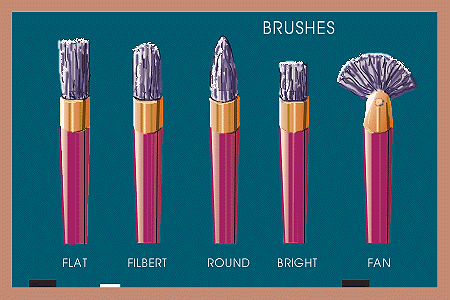- Flat: is characterized by its long flat bristles. Used for long fluid strokes and can be used to create a sharp edge.
- Filbert: much like the flat, but with a slightly rounded edge. This brush can create softened strokes with rounded edges.
- Round: characterized by its round barrel and staggered bristle lengths. Used for long continuous lines. Makes interesteing edges when rolled in the hand as the brush stroke is applied.
- Bright: characterized by its short flat bristles. For controlled detailing and can be used to create sharp edges.
- Fan: characterized by its fanned out flat bristles. Used for soft edges and subtle blending.
PALETTE KNIFE
- This versatile tool can be used for mixing paint on the palette, for scraping off paint, and for applying paint to the canvas.
 PALETTE
PALETTE
- Is a flat piece of material that serves as a place for mixing and working with the paint before it is applied to the canvas. A pane of glass with a piece of white paper attatched to the back makes a good palette. This kind of palette is versatile because it can be easily cleaned, the paper can be changed to match the color of the painting ground (for better color choices), and the surface will have no adverse effects on the paint. Palette pads, pieces of metal, and enamel surfaces can be used. It is important to have a surface that can be scraped with a razor knife for easy cleanup.
RAGS
- Yes, rags. They are used for cleanup and for applying paint. Rags can also be used for softened transitions when they are rubbed into painted surfaces.
updated 07/14/04 |
|
|


